The work of the cook is associated with a wide range of operations. Often, in the process of preparing dishes, he must conduct several technological processes of various kinds at once, without deviating from the requirements of existing norms and standards. Accordingly, to facilitate working conditions, the workplace should initially be organized appropriately. This applies not only to sanitary and environmental standards, but also to the ergonomics of the kitchen. The modern organization of the cook’s workplace aims to provide comfort, convenience and productivity. To achieve these goals, special rules are used.

The main characteristics of the workplace
Accessibility to shelves is one of the key characteristics that determine the ergonomics of the workplace. So, from the floor to the top shelf, the distance should not exceed 1.75 cm. Kitchen tools, tools and accessories can be placed on it. The height to the middle shelf can be no more than 150 cm. This is the most accessible zone for the cook, therefore frequently used tools, products and utensils should be located at this level. In particular, it is recommended to place cutting boards here, integrate drawers and spices. The characterization of the cook’s workplace in terms of accessibility to the scales is also of great importance - as practice shows, in the cooking process it is most convenient to use electronic devices up to 5 kg in divisions by 2 g. The cook will be able to quickly weigh portioned foods, semi-finished products, bulk products, etc. . e. Again, for the convenience of operations, the cook should always have about 50 cm of free space around him.
Room Planning Requirements
To organize space even at the design stage follows from the calculation of ensuring a sequence of processes that should exclude oncoming traffic in a continuous mode. For example, when the finished dish is sent to the exit and is faced with the delivery of raw convenience foods. Such situations are excluded under the conditions of proper planning. Separate premises with refrigeration equipment should be provided for storage and temporary maintenance of perishable products. If we are talking about fast-food establishments, then it is advisable to use a single-zone configuration of the workplace. In this case, the cook’s desktop can have parameters of 65x75x170 cm and form a functional island directly in the center of the room. As for the decoration of wall surfaces, they are most often decorated with tiled material that is easy to clean. The tile itself or washable wallpaper should be wear-resistant, waterproof, environmentally friendly and not deformable under impact.
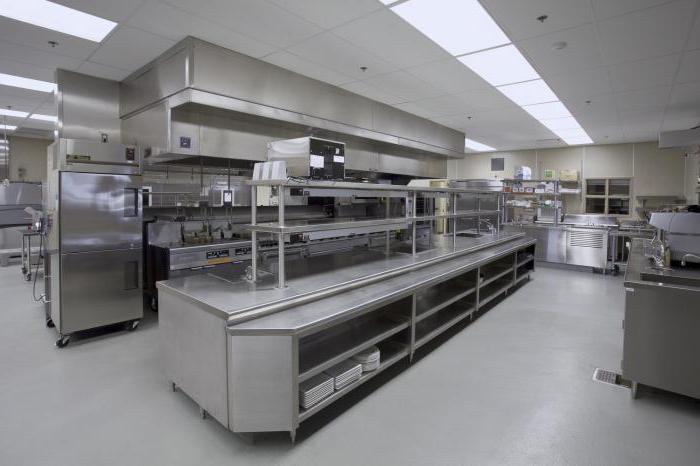
Microclimatic conditions in the room
In the room where the workplace is located, ventilation, conditioning, drying, washing and humidification of the air should be organized. To measure the speed of circulation of air flows, a special instrument is used - an anemometer. To measure small flows at a speed of 0.5 m / s, thermoelectric anemometers are used. The most important parameter in the microclimate is thermal radiation. It should not be higher than 70 W / m2. If this value is exceeded due to local equipment, then the organization of the cook's workplace should be provided with air conditioning, but this is also undesirable. Technologists recommend the use of other practical methods to minimize heat release:
- Timely turn off electric stoves and actively operating thermal appliances, using them if possible at minimum power.
- Fill the heated surfaces of the plates with heat-resistant dishes.
- Use air scenting in areas near stoves, ovens, ovens, etc.
Workplace lighting
In order to compensate for the negative radiation of technology, it is recommended to organize light through natural channels, if this is possible. Otherwise, you can focus on artificial sources, but without the effect of brilliance. In large rooms, fluorescent lights can be used. They are characterized by economy and high performance, which makes it possible to cover large areas. However, in places where creams, dough mixers, circular knives and universal drive mechanisms are supposed to work, fluorescent lamps must be integrated in antiphase. In certain areas, the organization of the cook's workplace may allow the use of LEDs and incandescent lamps. The advantages of such devices include the fact that their light is less tiring for the eyes. When performing lengthy spot operations, this feature is very important. Also, without fail, all lighting devices must have a high degree of protection of at least IP56 class.
Kitchen appliances
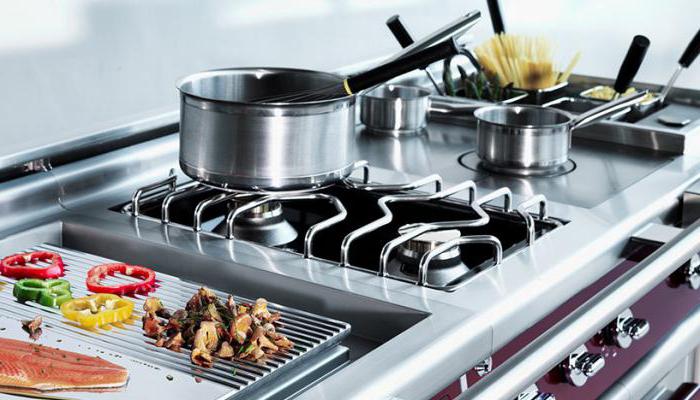
Full-fledged work of public catering establishments is impossible without the use of appropriate equipment. Moreover, the profession of a cook is associated with the performance of not only typical universal, but also specialized actions. The main equipment for performing storage and cooking operations can be divided into several categories. It will be refrigeration, thermal, electrical and modern induction equipment, as well as technological devices. The category of refrigeration equipment can be attributed directly to refrigerators with freezers (cabinets, built-in installations, mobile containers), work tables with the effect of cooling, showcases, etc. Thermal technology is ovens (modular, microwave, conventional), stoves, smokehouses, fryers and other units. Electromechanical and induction systems can be attributed to both refrigeration and thermal equipment. They are often designed to perform small-volume heating or cooling operations.
A separate group is represented by aggregates, instruments and devices with the help of which specialized operations are performed. For example, professional kitchen devices in the household of a regular restaurant can be represented by dough mixing machines, cleaning machines, percolators, food warmers, graniters, knives for fish, meat, shawarma, vegetables, etc.
Cooking utensils
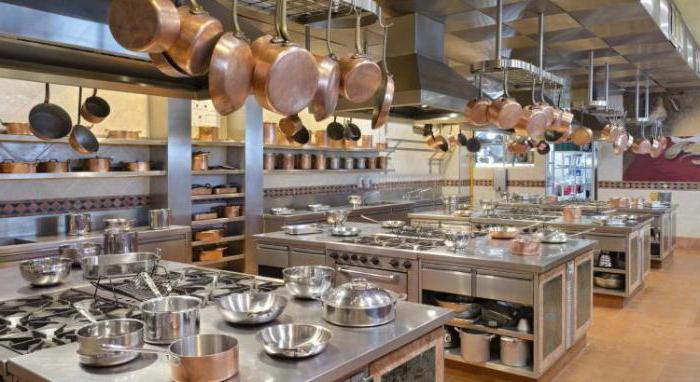
At the workplace there should be such a quantity of dishes that will be enough to serve the needs of a particular institution. Neither more nor less. Deformed and damaged objects with cracks, chips, broken parts should not be used and simply kept as auxiliary means. Directly organizing a cook’s workplace when preparing a dish involves preparing dishes made of stainless steel. Duralumin and aluminum utensils are used for the preparation and short-term maintenance of products. The cook practically does not interact with fragile cutlery during operation.
Kitchen tools
A considerable segment of devices is represented by auxiliary means, kitchen appliances and accessories, simplifying the execution of technological operations.Such equipment includes cutting boards, chopping blocks, graters, supports, trays, etc. Each unit of such equipment should be marked accordingly, because it is undesirable to use the same cutting board for different products, for example. The organization of the cook’s workplace does not do without specialized appliances for certain types of dishes. For example, special knives and cutting boards are used for pizza, and nets of a certain size are used to work with bulk products.
Cleaning and washing equipment
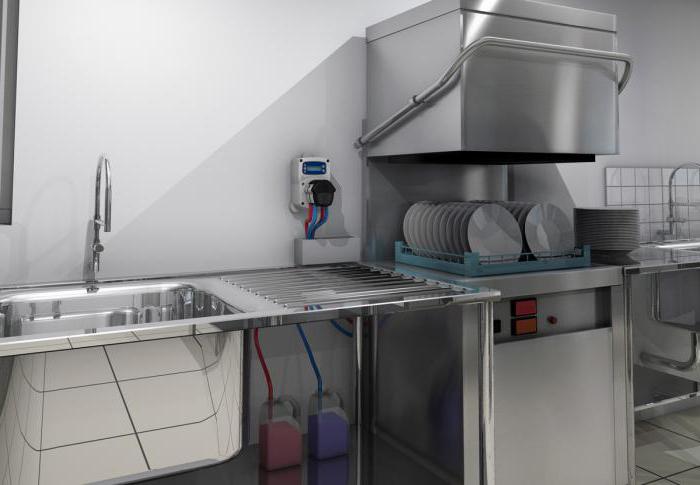
In equipping modern catering establishments, mechanical washers and utensils are actively used. As a rule, these are massive dishwashers that handle most of the kitchen utensils. However, manual washing processes cannot be completely ruled out. Three-section bathtubs are used to organize such procedures. They can wash glassware and accessories that are not allowed to be serviced in machines. Two-section bathtubs are usually used in small establishments with a limited assortment. In addition, the technical equipment and organization of the cook's workplace provides for the arrangement of special racks for the temporary maintenance of dishwasher-washed dishes. For example, cassette drawers can be located close to heat fluxes, which will speed up the drying process. Braziers, oven chambers and oven chambers are cleaned by hand with special brushes using kitchen disinfectant chemicals.
Organization of food storage

For long-term and short-term maintenance of products refrigerators, refrigerators and cabinets with natural temperature conditions are used. The choice of storage location depends on the characteristics of a particular product. With regard to special equipment, for convenience it should be provided with shelving, containers, boxes, as well as means of collection and removal of condensate. Standard recommendations for the preparation of the cook’s workplace, which works with carcasses, include the use of hanging beams with hooks. They allow you to lay meat or fish from the same freezer on a cutting table without much hassle. Offal, in turn, can remain directly in the container of the supplier (shelves, racks) until they reach the turn.
Organization of work outdoors
There are many dishes that are prepared outdoors. For this, remote sites are organized on which braziers, barbecues, boilers and grills are installed - the choice of equipment is carried out depending on the variety of the culinary process. Such sites are pavilions connected to the sewer and water supply. If we are talking about the constant work of such kitchen departments, it is recommended to organize food storage facilities within the same limits. As the general rules of the cook at the workplace require, in this case it is especially important to maintain personal hygiene and generally observe sanitary conditions. Do not forget about the rules of fire safety. Fire sources should be located 50 m from residential buildings.
Conclusion
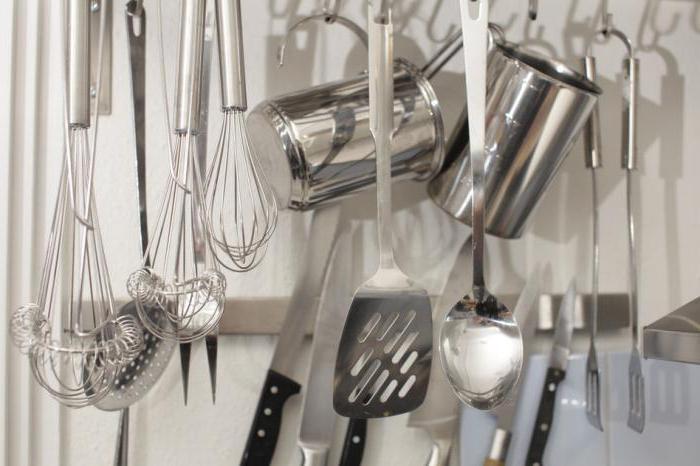
The standards for organizing working conditions within the kitchen practically do not change for decades. In any case, the principles remain the same. The place must comply with sanitary requirements, be ergonomic, functional and safe. But just the technical side of the organization of space is not enough for the full-fledged work of the institution. It is important to consider that the profession of a cook also places high demands on the bearer of this title. A person must have an appropriate education, a certificate of medical examination and a list of personal qualities that will allow you to work in a particular institution.It will have a high responsibility not only for the quality of prepared dishes, but also for maintaining fire safety in the working room.